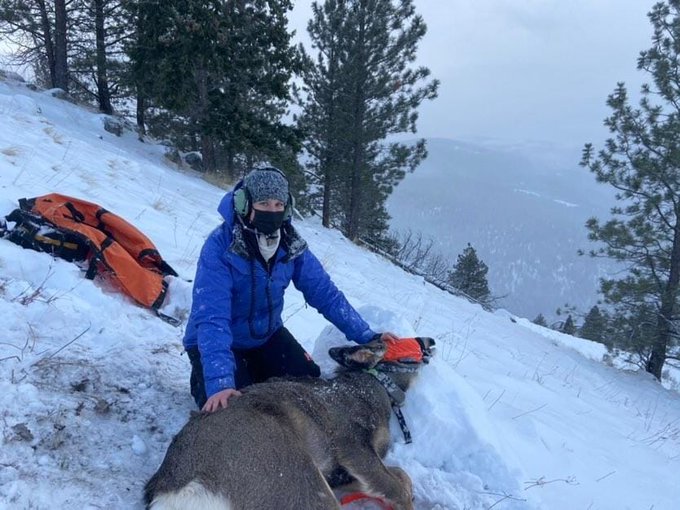Current research projects
1) The Southern Interior Mule Deer Project - Southern British Columbia is experiencing widespread and rapid landscape change. Forest fires, resource extraction, road building mining, urbanization, and climate change are affecting the availability of habitat and how organism interact with their environment. The WiRE Lab is working to understand and manage the impacts of these changes. A First Nation. multi-university, NGO, government, and citizen collaboration that is linking the effects of landscape change on the movement, demography, and predator-prey interactions of one of BC's most important wildlife species, the mule deer. This project is the single largest mule deer research project to occur in British Columbia - ever.

2) The Southern BC Cougar Project - https://bccougarproject.weebly.com/ Cougars (Puma concolor) are the most wide-ranging carnivore in the Americas, requiring large, well-connected habitat and sources of ungulate prey to maintain stable populations. In southern British Columbia, cougars are understudied predators of declining mule deer (Odocoileus hemionus) and other large ungulates. The landscape is characterized by land modification from wildfire, urbanization, forestry, and roads that may influence cougar habitat use and prey choice. Where cougars kill their prey may further influence scavenging communities that benefit from carrion.
3) The spatial ecology of disease in restoring landscapes - ungulates are vulnerable to diseases - from Psoroptes mites to Mycoplasma ovipneumoniae bacteria to Chronic Wasting Disease. The spread of infection from these diseases is linked to the movement and connectivity of landscapes. The demography of infected populations is also tied to resource availability and predation. Fire and predator activity are linked to habitat quality and habitat is changing. With partnerships among NGO, government, and First Nations, the WiRE Lab is seeking to better understand how we can manage connectivity in a way that enables populations of vulnerable species to exist.
3) The spatial ecology of disease in restoring landscapes - ungulates are vulnerable to diseases - from Psoroptes mites to Mycoplasma ovipneumoniae bacteria to Chronic Wasting Disease. The spread of infection from these diseases is linked to the movement and connectivity of landscapes. The demography of infected populations is also tied to resource availability and predation. Fire and predator activity are linked to habitat quality and habitat is changing. With partnerships among NGO, government, and First Nations, the WiRE Lab is seeking to better understand how we can manage connectivity in a way that enables populations of vulnerable species to exist.
4) Landscapes of coexistence - wildlife and people don't always know how to share space - especially when the animals threaten human safety or property, or when people threaten animals' access to critical resources. Working with partnerships in Canada's National and Provincial Parks, and surrounding areas, the WiRE Lab is working to quantify pathways towards coexistence. Our work includes wolf conflict on coastal BC, to bear conflict in the Rocky Mountains, to goats in southern BC. We will expose the mechanisms that lead to conflict and inform the ecology through with which socio-ecological systems of coexistence are resolved.
5) Road and corridor ecology. One of the leading methods used to curb the effects of habitat fragmentation involves wildlife corridors – linear areas set aside from human development to facilitate the movement of organisms among habitat patches. Rooted in the foundational theories of spatial ecology, island biogeography, and metapopulation ecology, corridors have been an important tool in conservation and wildlife management since the 1970s. Despite their intuitive appeal and widespread implementation, scientific understanding of how to optimize corridor design and quantify their functionality is lacking (see the 'desperate plea' from Beier and Gregory, 2012).The WiRE Lab is helping to fill this knowledge gap by linking recently developed theory in movement ecology with long-term monitoring data from snow tracking and telemetry to quantify corridor functionality for an assemblage of large mammals (wolves, cougars, G- and B- bears, elk, moose, deer, lynx) in the Rocky Mountains.
6) The spatial drivers of food webs - from fundamental to applied outcomes - Ecologists have long been vexed by the consequences of space in shaping which species interact and what the outcomes of those interactions are. The WiRE Lab and it's collaborators are looking at how African wild dogs, leopards, lions, tigers, wolves, hirola antelope, mountain caribou,impala, dik-dik, and other species are affected by resources, by people, and by spatial variation in the landscape of fear. The consequences of this work range from quantifying trophic cascades to evaluating management options to restore endangered species.
7) Environmental Assessment and other policy-relevant science - The WiRE Lab is outward looking and seeks to challenge hypothesis with data, and opinion with evidence. We are constantly searching for avenues through which our skills in ecology can help bring people together to make better decisions. One of these avenues is in the field of environmental assessment. Here, we advocate for a more rigorous uptake of ( and investment in) science so that decision makers can provide more transparent and defensible choices for society - from industry to the local communities most impacted by resource management outcomes.
7) Environmental Assessment and other policy-relevant science - The WiRE Lab is outward looking and seeks to challenge hypothesis with data, and opinion with evidence. We are constantly searching for avenues through which our skills in ecology can help bring people together to make better decisions. One of these avenues is in the field of environmental assessment. Here, we advocate for a more rigorous uptake of ( and investment in) science so that decision makers can provide more transparent and defensible choices for society - from industry to the local communities most impacted by resource management outcomes.



